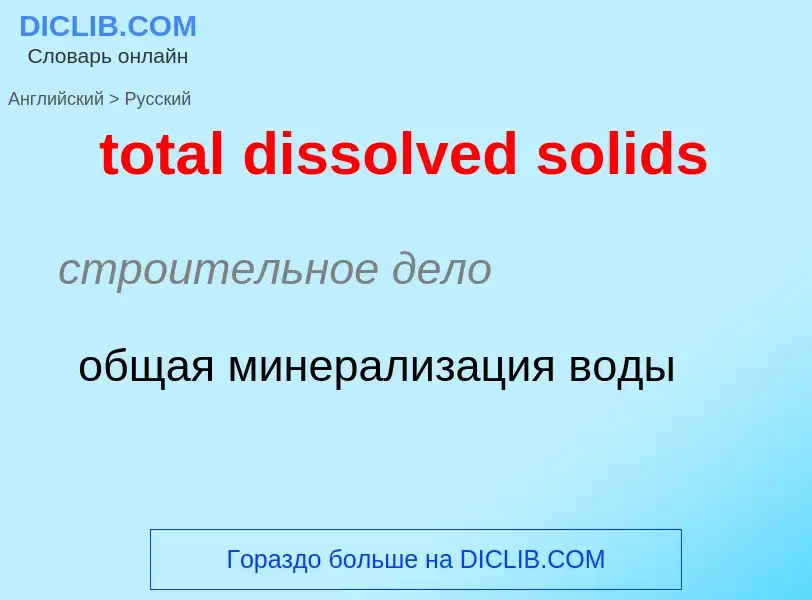Tradução e análise de palavras por inteligência artificial ChatGPT
Nesta página você pode obter uma análise detalhada de uma palavra ou frase, produzida usando a melhor tecnologia de inteligência artificial até o momento:
- como a palavra é usada
- frequência de uso
- é usado com mais frequência na fala oral ou escrita
- opções de tradução de palavras
- exemplos de uso (várias frases com tradução)
- etimologia
total dissolved solids - tradução para russo
строительное дело
общая минерализация воды
строительное дело
растворённый органический углерод
Definição
Wikipédia

Total dissolved solids (TDS) is a measure of the dissolved combined content of all inorganic and organic substances present in a liquid in molecular, ionized, or micro-granular (colloidal sol) suspended form. TDS concentrations are often reported in parts per million (ppm). Water TDS concentrations can be determined using a digital meter.
Generally, the operational definition is that the solids must be small enough to survive filtration through a filter with 2-micrometer (nominal size, or smaller) pores. Total dissolved solids are normally discussed only for freshwater systems, as salinity includes some of the ions constituting the definition of TDS. The principal application of TDS is in the study of water quality for streams, rivers, and lakes. Although TDS is not generally considered a primary pollutant (e.g. it is not deemed to be associated with health effects), it is used as an indication of aesthetic characteristics of drinking water and as an aggregate indicator of the presence of a broad array of chemical contaminants.
Primary sources for TDS in receiving waters are agricultural runoff and residential (urban) runoff, clay-rich mountain waters, leaching of soil contamination, and point source water pollution discharge from industrial or sewage treatment plants. The most common chemical constituents are calcium, phosphates, nitrates, sodium, potassium, and chloride, which are found in nutrient runoff, general stormwater runoff and runoff from snowy climates where road de-icing salts are applied. The chemicals may be cations, anions, molecules or agglomerations on the order of one thousand or fewer molecules, so long as a soluble micro-granule is formed. More exotic and harmful elements of TDS are pesticides arising from surface runoff. Certain naturally occurring total dissolved solids arise from the weathering and dissolution of rocks and soils. The United States has established a secondary water quality standard of 500 mg/L to provide for palatability of drinking water.
Total dissolved solids are differentiated from total suspended solids (TSS), in that the latter cannot pass through a sieve of 2 micrometers and yet are indefinitely suspended in solution. The term settleable solids refers to material of any size that will not remain suspended or dissolved in a holding tank not subject to motion, and excludes both TDS and TSS. Settleable solids may include larger particulate matter or insoluble molecules.
Total dissolved solids include both volatile and non-volatile solids. Volatile solids are ones that can easily go from a solid to a liquid state. Non-volatile solids must be heated to a high temperature, typically 550 °C, in order to achieve this state change. Examples of non-volatile substances include salts and sugars.


![Pyramid Lake, Nevada]], receives dissolved solids from the [[Truckee River]]. Pyramid Lake, Nevada]], receives dissolved solids from the [[Truckee River]].](https://commons.wikimedia.org/wiki/Special:FilePath/Pyramid Lake sat.jpg?width=200)



![50px]] Material was copied from this source, which is available under a [https://creativecommons.org/licenses/by/4.0/ Creative Commons Attribution 4.0 International License].</ref> 50px]] Material was copied from this source, which is available under a [https://creativecommons.org/licenses/by/4.0/ Creative Commons Attribution 4.0 International License].</ref>](https://commons.wikimedia.org/wiki/Special:FilePath/DOC net production, transport and export in the ocean.png?width=200)
![50px]] Material was copied from this source, which is available under a [https://creativecommons.org/licenses/by/4.0/ Creative Commons Attribution 4.0 International License].</ref> 50px]] Material was copied from this source, which is available under a [https://creativecommons.org/licenses/by/4.0/ Creative Commons Attribution 4.0 International License].</ref>](https://commons.wikimedia.org/wiki/Special:FilePath/Dissolved organic carbon fluxes in the surface, mesopelagic, and interior ocean.jpg?width=200)
![50px]] Material was copied from this source, which is available under a [https://creativecommons.org/licenses/by/4.0/ Creative Commons Attribution 4.0 International License].</ref> 50px]] Material was copied from this source, which is available under a [https://creativecommons.org/licenses/by/4.0/ Creative Commons Attribution 4.0 International License].</ref>](https://commons.wikimedia.org/wiki/Special:FilePath/Interface between peatland draining river water and coastal waters.png?width=200)


![50px]] Material was copied from this source, which is available under a [https://creativecommons.org/licenses/by/4.0/ Creative Commons Attribution 4.0 International License].}} 50px]] Material was copied from this source, which is available under a [https://creativecommons.org/licenses/by/4.0/ Creative Commons Attribution 4.0 International License].}}](https://commons.wikimedia.org/wiki/Special:FilePath/Removal of refractory DOC in the ocean.webp?width=200)

